Input interpretation

HCl hydrogen chloride + Na_2O_2 sodium peroxide ⟶ H_2O water + O_2 oxygen + NaCl sodium chloride
Balanced equation
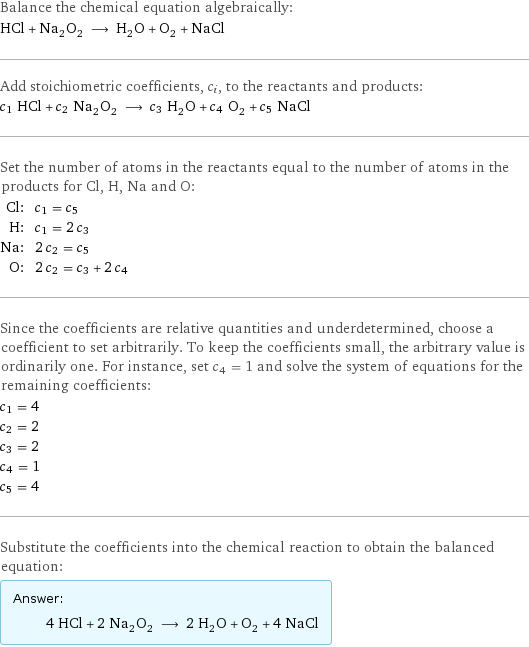
Balance the chemical equation algebraically: HCl + Na_2O_2 ⟶ H_2O + O_2 + NaCl Add stoichiometric coefficients, c_i, to the reactants and products: c_1 HCl + c_2 Na_2O_2 ⟶ c_3 H_2O + c_4 O_2 + c_5 NaCl Set the number of atoms in the reactants equal to the number of atoms in the products for Cl, H, Na and O: Cl: | c_1 = c_5 H: | c_1 = 2 c_3 Na: | 2 c_2 = c_5 O: | 2 c_2 = c_3 + 2 c_4 Since the coefficients are relative quantities and underdetermined, choose a coefficient to set arbitrarily. To keep the coefficients small, the arbitrary value is ordinarily one. For instance, set c_4 = 1 and solve the system of equations for the remaining coefficients: c_1 = 4 c_2 = 2 c_3 = 2 c_4 = 1 c_5 = 4 Substitute the coefficients into the chemical reaction to obtain the balanced equation: Answer: | | 4 HCl + 2 Na_2O_2 ⟶ 2 H_2O + O_2 + 4 NaCl
Structures

+ ⟶ + +
Names

hydrogen chloride + sodium peroxide ⟶ water + oxygen + sodium chloride
Reaction thermodynamics
Enthalpy
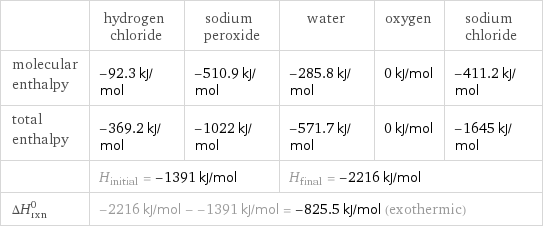
| hydrogen chloride | sodium peroxide | water | oxygen | sodium chloride molecular enthalpy | -92.3 kJ/mol | -510.9 kJ/mol | -285.8 kJ/mol | 0 kJ/mol | -411.2 kJ/mol total enthalpy | -369.2 kJ/mol | -1022 kJ/mol | -571.7 kJ/mol | 0 kJ/mol | -1645 kJ/mol | H_initial = -1391 kJ/mol | | H_final = -2216 kJ/mol | | ΔH_rxn^0 | -2216 kJ/mol - -1391 kJ/mol = -825.5 kJ/mol (exothermic) | | | |
Gibbs free energy

| hydrogen chloride | sodium peroxide | water | oxygen | sodium chloride molecular free energy | -95.3 kJ/mol | -447.7 kJ/mol | -237.1 kJ/mol | 231.7 kJ/mol | -384.1 kJ/mol total free energy | -381.2 kJ/mol | -895.4 kJ/mol | -474.2 kJ/mol | 231.7 kJ/mol | -1536 kJ/mol | G_initial = -1277 kJ/mol | | G_final = -1779 kJ/mol | | ΔG_rxn^0 | -1779 kJ/mol - -1277 kJ/mol = -502.3 kJ/mol (exergonic) | | | |
Entropy
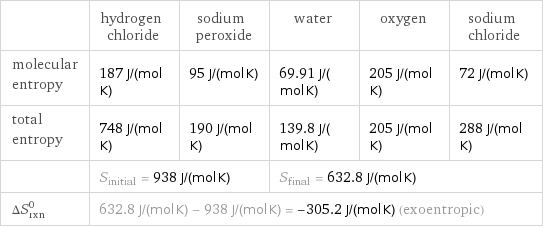
| hydrogen chloride | sodium peroxide | water | oxygen | sodium chloride molecular entropy | 187 J/(mol K) | 95 J/(mol K) | 69.91 J/(mol K) | 205 J/(mol K) | 72 J/(mol K) total entropy | 748 J/(mol K) | 190 J/(mol K) | 139.8 J/(mol K) | 205 J/(mol K) | 288 J/(mol K) | S_initial = 938 J/(mol K) | | S_final = 632.8 J/(mol K) | | ΔS_rxn^0 | 632.8 J/(mol K) - 938 J/(mol K) = -305.2 J/(mol K) (exoentropic) | | | |
Equilibrium constant
![Construct the equilibrium constant, K, expression for: HCl + Na_2O_2 ⟶ H_2O + O_2 + NaCl Plan: • Balance the chemical equation. • Determine the stoichiometric numbers. • Assemble the activity expression for each chemical species. • Use the activity expressions to build the equilibrium constant expression. Write the balanced chemical equation: 4 HCl + 2 Na_2O_2 ⟶ 2 H_2O + O_2 + 4 NaCl Assign stoichiometric numbers, ν_i, using the stoichiometric coefficients, c_i, from the balanced chemical equation in the following manner: ν_i = -c_i for reactants and ν_i = c_i for products: chemical species | c_i | ν_i HCl | 4 | -4 Na_2O_2 | 2 | -2 H_2O | 2 | 2 O_2 | 1 | 1 NaCl | 4 | 4 Assemble the activity expressions accounting for the state of matter and ν_i: chemical species | c_i | ν_i | activity expression HCl | 4 | -4 | ([HCl])^(-4) Na_2O_2 | 2 | -2 | ([Na2O2])^(-2) H_2O | 2 | 2 | ([H2O])^2 O_2 | 1 | 1 | [O2] NaCl | 4 | 4 | ([NaCl])^4 The equilibrium constant symbol in the concentration basis is: K_c Mulitply the activity expressions to arrive at the K_c expression: Answer: | | K_c = ([HCl])^(-4) ([Na2O2])^(-2) ([H2O])^2 [O2] ([NaCl])^4 = (([H2O])^2 [O2] ([NaCl])^4)/(([HCl])^4 ([Na2O2])^2)](../image_source/a263ca490cb5a77b55b4c82bdd68b429.png)
Construct the equilibrium constant, K, expression for: HCl + Na_2O_2 ⟶ H_2O + O_2 + NaCl Plan: • Balance the chemical equation. • Determine the stoichiometric numbers. • Assemble the activity expression for each chemical species. • Use the activity expressions to build the equilibrium constant expression. Write the balanced chemical equation: 4 HCl + 2 Na_2O_2 ⟶ 2 H_2O + O_2 + 4 NaCl Assign stoichiometric numbers, ν_i, using the stoichiometric coefficients, c_i, from the balanced chemical equation in the following manner: ν_i = -c_i for reactants and ν_i = c_i for products: chemical species | c_i | ν_i HCl | 4 | -4 Na_2O_2 | 2 | -2 H_2O | 2 | 2 O_2 | 1 | 1 NaCl | 4 | 4 Assemble the activity expressions accounting for the state of matter and ν_i: chemical species | c_i | ν_i | activity expression HCl | 4 | -4 | ([HCl])^(-4) Na_2O_2 | 2 | -2 | ([Na2O2])^(-2) H_2O | 2 | 2 | ([H2O])^2 O_2 | 1 | 1 | [O2] NaCl | 4 | 4 | ([NaCl])^4 The equilibrium constant symbol in the concentration basis is: K_c Mulitply the activity expressions to arrive at the K_c expression: Answer: | | K_c = ([HCl])^(-4) ([Na2O2])^(-2) ([H2O])^2 [O2] ([NaCl])^4 = (([H2O])^2 [O2] ([NaCl])^4)/(([HCl])^4 ([Na2O2])^2)
Rate of reaction
![Construct the rate of reaction expression for: HCl + Na_2O_2 ⟶ H_2O + O_2 + NaCl Plan: • Balance the chemical equation. • Determine the stoichiometric numbers. • Assemble the rate term for each chemical species. • Write the rate of reaction expression. Write the balanced chemical equation: 4 HCl + 2 Na_2O_2 ⟶ 2 H_2O + O_2 + 4 NaCl Assign stoichiometric numbers, ν_i, using the stoichiometric coefficients, c_i, from the balanced chemical equation in the following manner: ν_i = -c_i for reactants and ν_i = c_i for products: chemical species | c_i | ν_i HCl | 4 | -4 Na_2O_2 | 2 | -2 H_2O | 2 | 2 O_2 | 1 | 1 NaCl | 4 | 4 The rate term for each chemical species, B_i, is 1/ν_i(Δ[B_i])/(Δt) where [B_i] is the amount concentration and t is time: chemical species | c_i | ν_i | rate term HCl | 4 | -4 | -1/4 (Δ[HCl])/(Δt) Na_2O_2 | 2 | -2 | -1/2 (Δ[Na2O2])/(Δt) H_2O | 2 | 2 | 1/2 (Δ[H2O])/(Δt) O_2 | 1 | 1 | (Δ[O2])/(Δt) NaCl | 4 | 4 | 1/4 (Δ[NaCl])/(Δt) (for infinitesimal rate of change, replace Δ with d) Set the rate terms equal to each other to arrive at the rate expression: Answer: | | rate = -1/4 (Δ[HCl])/(Δt) = -1/2 (Δ[Na2O2])/(Δt) = 1/2 (Δ[H2O])/(Δt) = (Δ[O2])/(Δt) = 1/4 (Δ[NaCl])/(Δt) (assuming constant volume and no accumulation of intermediates or side products)](../image_source/4d3ec793157e5220e5185b1d1927b5fd.png)
Construct the rate of reaction expression for: HCl + Na_2O_2 ⟶ H_2O + O_2 + NaCl Plan: • Balance the chemical equation. • Determine the stoichiometric numbers. • Assemble the rate term for each chemical species. • Write the rate of reaction expression. Write the balanced chemical equation: 4 HCl + 2 Na_2O_2 ⟶ 2 H_2O + O_2 + 4 NaCl Assign stoichiometric numbers, ν_i, using the stoichiometric coefficients, c_i, from the balanced chemical equation in the following manner: ν_i = -c_i for reactants and ν_i = c_i for products: chemical species | c_i | ν_i HCl | 4 | -4 Na_2O_2 | 2 | -2 H_2O | 2 | 2 O_2 | 1 | 1 NaCl | 4 | 4 The rate term for each chemical species, B_i, is 1/ν_i(Δ[B_i])/(Δt) where [B_i] is the amount concentration and t is time: chemical species | c_i | ν_i | rate term HCl | 4 | -4 | -1/4 (Δ[HCl])/(Δt) Na_2O_2 | 2 | -2 | -1/2 (Δ[Na2O2])/(Δt) H_2O | 2 | 2 | 1/2 (Δ[H2O])/(Δt) O_2 | 1 | 1 | (Δ[O2])/(Δt) NaCl | 4 | 4 | 1/4 (Δ[NaCl])/(Δt) (for infinitesimal rate of change, replace Δ with d) Set the rate terms equal to each other to arrive at the rate expression: Answer: | | rate = -1/4 (Δ[HCl])/(Δt) = -1/2 (Δ[Na2O2])/(Δt) = 1/2 (Δ[H2O])/(Δt) = (Δ[O2])/(Δt) = 1/4 (Δ[NaCl])/(Δt) (assuming constant volume and no accumulation of intermediates or side products)
Chemical names and formulas
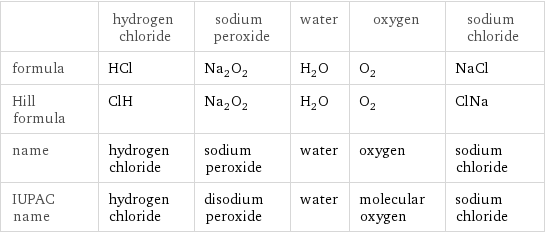
| hydrogen chloride | sodium peroxide | water | oxygen | sodium chloride formula | HCl | Na_2O_2 | H_2O | O_2 | NaCl Hill formula | ClH | Na_2O_2 | H_2O | O_2 | ClNa name | hydrogen chloride | sodium peroxide | water | oxygen | sodium chloride IUPAC name | hydrogen chloride | disodium peroxide | water | molecular oxygen | sodium chloride
Substance properties
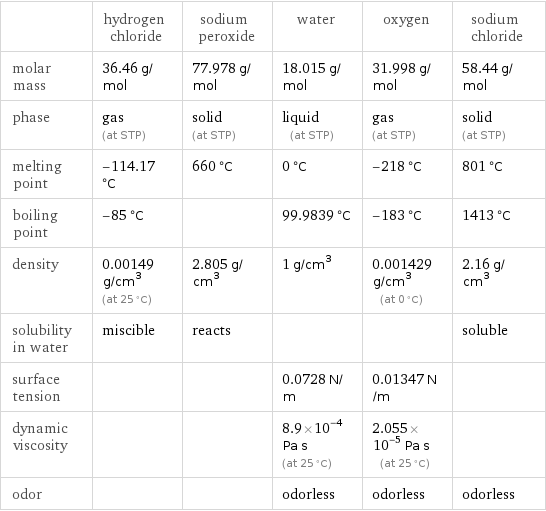
| hydrogen chloride | sodium peroxide | water | oxygen | sodium chloride molar mass | 36.46 g/mol | 77.978 g/mol | 18.015 g/mol | 31.998 g/mol | 58.44 g/mol phase | gas (at STP) | solid (at STP) | liquid (at STP) | gas (at STP) | solid (at STP) melting point | -114.17 °C | 660 °C | 0 °C | -218 °C | 801 °C boiling point | -85 °C | | 99.9839 °C | -183 °C | 1413 °C density | 0.00149 g/cm^3 (at 25 °C) | 2.805 g/cm^3 | 1 g/cm^3 | 0.001429 g/cm^3 (at 0 °C) | 2.16 g/cm^3 solubility in water | miscible | reacts | | | soluble surface tension | | | 0.0728 N/m | 0.01347 N/m | dynamic viscosity | | | 8.9×10^-4 Pa s (at 25 °C) | 2.055×10^-5 Pa s (at 25 °C) | odor | | | odorless | odorless | odorless
Units
